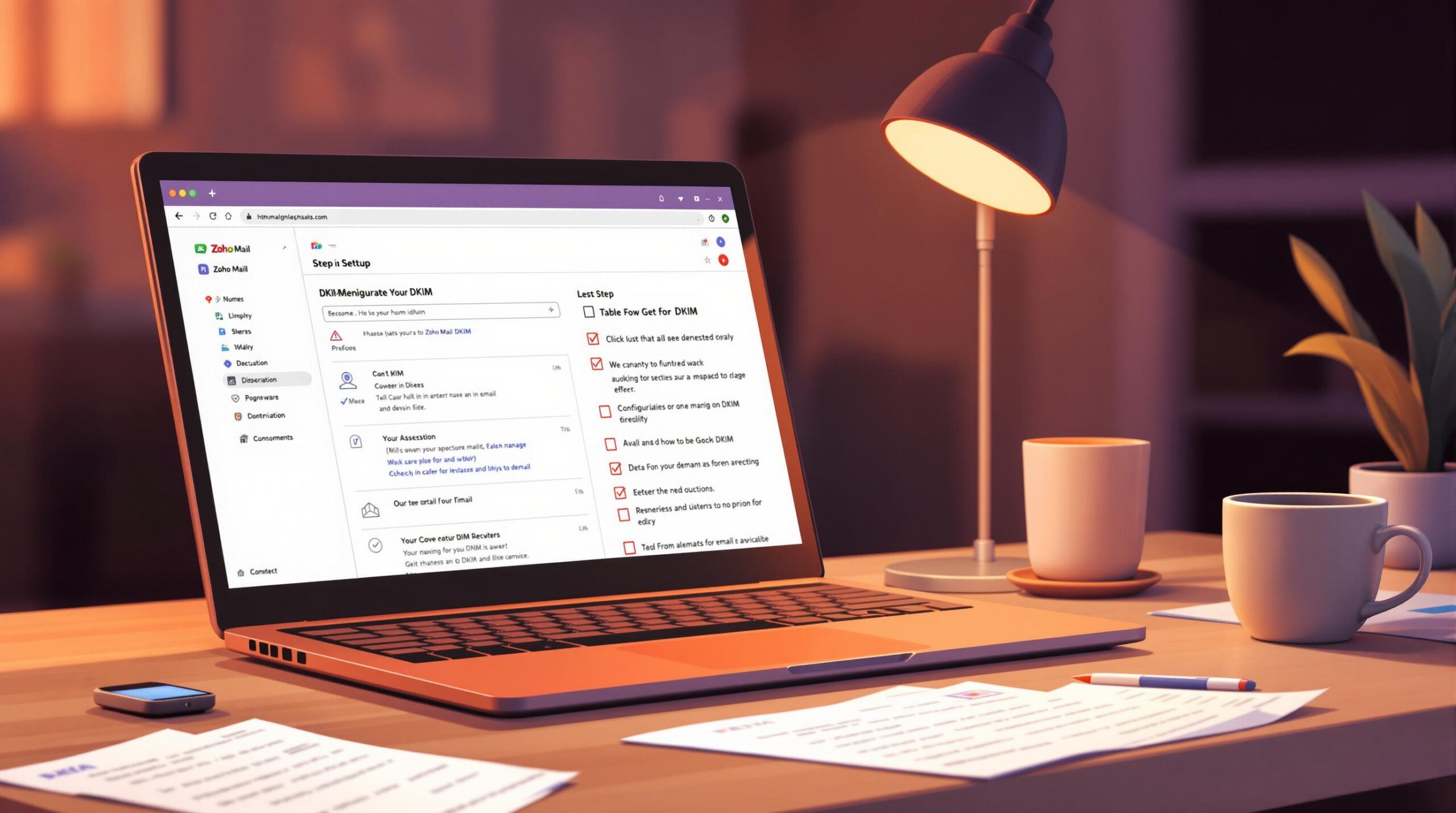Setting up DKIM (DomainKeys Identified Mail) for Zoho Mail ensures your emails are verified, secure, and less likely to be flagged as spam. Here’s a quick overview of the process:
- Why DKIM Matters: Improves email deliverability, protects against spam and phishing, and boosts your domain’s reputation.
- What You Need: Zoho Mail admin rights and access to your domain’s DNS settings.
- Steps to Set Up DKIM:
- Log in to Zoho Mail’s admin panel.
- Create a DKIM selector and generate a key pair.
- Copy the DKIM TXT record provided by Zoho Mail.
- Add the record to your domain’s DNS settings.
- Verify and enable DKIM in Zoho Mail.
Pro Tip: Use tools like a DKIM record checker to validate your setup. Once configured, DKIM ensures your emails are authenticated and tamper-proof, enhancing your email security and deliverability.
How to configure MX, SPF, DKIM for Cloudflare domain

Required Setup Items
Before setting up DKIM, ensure you have Zoho Mail admin rights and DNS control access.
Zoho Mail Admin Rights

To implement DKIM, you need one of these roles:
- Super Administrator: Has complete control over the domain.
- Administrator: Can manage most settings, including email security.
- Custom Administrator: Must have permissions specifically for email security tasks.
DNS Control Access
You’ll need access to your domain’s DNS settings, typically through your domain registrar or DNS provider. This is crucial for adding DKIM records.
| DNS Provider | Notes on Implementation |
|---|---|
| GoDaddy | Automatically appends your domain name to DNS records. |
| Wix | Requires a specific format for TXT records. |
| Namecheap | Accepts standard DNS record formats. |
| Squarespace | Has a unique interface with specific configuration details. |
If you don’t have DNS access, reach out to your IT team or domain administrator to make the required changes. Without this access, you won’t be able to complete DKIM setup, which may impact your email deliverability and domain’s reputation.
Once you’ve confirmed admin rights and DNS access, you’re ready to generate your DKIM keys.
Creating DKIM Keys
To set up DKIM keys in Zoho Mail, you’ll need to access the control panel, locate the appropriate settings, and create a new DKIM selector for your domain.
Finding DKIM Options
Follow these steps to access the DKIM settings in Zoho Mail:
- Go to https://mailadmin.zoho.com and log in with your administrator credentials.
- Click on Domains in the left-hand menu.
- Select your domain from the displayed list.
- Open the Email Configuration tab.
- Click on DKIM to proceed.
Setting Up a DKIM Selector
A DKIM selector is used to identify the public DKIM key for your domain. Here’s how to create one:
- In the DKIM section, click Add.
- Enter a selector name, such as "zoho" or "s1".
- Click Add again to generate your DKIM key pair.
| DNS Provider Type | Selector Format |
|---|---|
| Standard DNS | selector._domainkey.yourdomain.com |
| Auto-append DNS* | selector._domainkey |
| Custom DNS | Refer to your provider’s documentation |
*Providers like GoDaddy, Wix, Squarespace, and Namecheap automatically add your domain name to the selector.
Once the key pair is generated, copy the DKIM TXT record for use in DNS configuration.
Getting the DKIM Record
After setting up your selector, Zoho Mail will create a DKIM TXT record. This record includes your public key and other configuration details.
"The selector is used to identify the public DKIM Key details of the Domain." – Zoho Mail Help
You’ll find the TXT record displayed below your selector in Zoho Mail. Make sure to copy it exactly as shown, as you’ll need it to update your DNS settings.
sbb-itb-f42cab2
DNS Record Setup
Once you have your DKIM record from Zoho Mail, the next step is to update your DNS settings to ensure proper email authentication. Here’s how to get it done.
Accessing Your DNS Settings
Start by logging into your domain provider’s DNS management interface. The steps to access these settings depend on your provider. Here’s a quick guide for some popular ones:
| DNS Provider | How to Access DNS Settings |
|---|---|
| GoDaddy | My Account > Domains > Manage DNS |
| Namecheap | Domain List > Advanced DNS |
| Cloudflare | Select Domain > DNS > Records |
| Bluehost | Domains > Zone Editor |
If your domain is set up with custom name servers pointing to your hosting provider, you’ll need to manage DNS settings through your hosting control panel instead.
Once you’re in the DNS management interface, you’re ready to add your DKIM record.
Adding the DKIM Record
To add the DKIM record, create a new TXT record. Here’s what you need to do:
- Set the name as
<selector>._domainkey.<yourdomain.com>. - Paste the DKIM TXT record you copied from Zoho Mail into the value field.
- Set the TTL to the default value or 3600 seconds.
"The process to create a TXT record varies based on the DNS Provider/Manager you use" .
For example, if you’re using GoDaddy, go to My Account > Domains > Manage DNS, and add the TXT record with the correct selector and DKIM value.
Allowing Time for DNS Updates
After making changes, keep in mind that DNS updates aren’t instant. It typically takes 24-48 hours for the changes to propagate. During this time, avoid making additional DNS changes. If the changes don’t appear after the propagation period, double-check your configuration or reach out to your provider’s support team for assistance.
Testing DKIM Setup
Verifying your DKIM setup and enabling it in Zoho Mail is essential for proper email authentication and ensuring your emails are signed correctly.
Checking DNS Setup
To confirm your DNS configuration, use a third-party DKIM checker tool like the Mimecast DKIM Record Check. Enter your domain and selector to:
- Confirm the DKIM record is detected.
- Validate the key length.
- Ensure the tag formats are correct.
Turning On DKIM
Once the DNS record is set up correctly, follow these steps to activate DKIM in Zoho Mail:
- Log in to the Zoho Mail Control Panel.
- Go to the DKIM settings section.
- Find your selector and click "Verify."
- Wait until the status updates to "Verified."
- Enable DKIM when prompted.
After activation, Zoho Mail will automatically add DKIM signatures to all outgoing emails from your domain. This ensures receiving servers can verify that your emails remain unchanged during transit.
Fixing Common Problems
| Common Issue | Solution |
|---|---|
| Incorrect DNS Value | Double-check the DKIM record copied from Zoho for accuracy. |
| Domain Name Issues | If your DNS provider auto-appends domain names, use "selector._domainkey" as the record name. |
| Slow Propagation | High TTL values (24–48 hours) can delay updates. |
| Verification Failures | Use DKIM checker tools to validate the record’s format and values. |
Keep in mind, DKIM works only for emails sent directly through Zoho Mail. It won’t apply to domains using Email Routing, Outbound Gateways, or emails sent from external servers.
If problems persist, ensure:
- The DKIM key is copied exactly as shown in Zoho’s setup.
- The TXT record name follows the required format.
- Your DNS provider’s rules for adding authentication records are met.
Once these issues are resolved, you can finalize DKIM activation through Zoho Mail’s control panel.
Using Bouncebuster

Once DKIM is verified, you can take email deliverability a step further by adding address verification.
About Bouncebuster
Bouncebuster is a real-time email verification tool that works seamlessly with Zoho Mail’s DKIM. It helps safeguard your domain reputation by checking email addresses before you send messages, reducing bounce rates and improving the performance of your DKIM authentication .
Bouncebuster provides three main verification options:
| Verification Method | Description | Best For |
|---|---|---|
| Manual Verification | Validates a single email address | Quick checks for individual contacts |
| Bulk Verification | Processes entire CSV/XLS files | Cleaning up large contact lists |
| REST API | Automates email verification | Real-time validation during system operations |
DKIM and Bouncebuster Combined
After ensuring email authenticity with DKIM, pairing it with Bouncebuster’s verification service can significantly improve email delivery rates. Together, Zoho Mail DKIM and Bouncebuster ensure that your emails are both authenticated and sent to valid recipients.
Here’s how this combination enhances your email setup:
-
Pre-Send Verification
Bouncebuster checks email addresses before sending, ensuring you’re only targeting valid recipients and minimizing bounce rates. -
API Integration
Use the REST API to automate contact verification within Zoho Mail, preventing invalid addresses from entering your system. -
Reputation Management
DKIM confirms your emails’ authenticity, while Bouncebuster ensures you’re sending to legitimate addresses. Together, they protect your domain’s reputation and improve overall delivery success.
Pro Tip: Set up DKIM first before integrating Bouncebuster for the best results.
Wrap-Up
After following the setup and verification steps, it’s important to review both your configuration and security practices to ensure everything is in place and functioning as intended.
Setup Steps Review
Setting up DKIM for Zoho Mail involves three main phases:
| Phase | Actions | Indicators |
|---|---|---|
| Key Generation | Create a DKIM key in the Zoho Mail admin panel | A unique public key value is generated |
| DNS Configuration | Add a TXT record to your DNS settings | Correct selector format (selector._domainkey) |
| Validation | Enable DKIM in Zoho Mail | DKIM signing is active for outgoing emails |
Double-check each phase to confirm all steps were completed successfully.
Pro Tip: For DNS providers like GoDaddy or WIX, only enter selector._domainkey to avoid common configuration mistakes .
Email Security Tips
Once DKIM is set up, take additional steps to boost your email security:
- Monitor DMARC reports: Regularly check these reports to identify and resolve potential issues early .
- Combine DKIM with SPF and DMARC: This trio helps reduce email spoofing risks and enhances deliverability .
"DKIM email authentication technique ensures that the email has originated from an authenticated source and that there has not been any tampering in transit." – DuoCircle
- Use DKIM checkers: These tools help you spot configuration errors before they impact email delivery .
- Keep your private keys secure: Never share your DKIM private keys, as the integrity of your authentication relies on their confidentiality .



